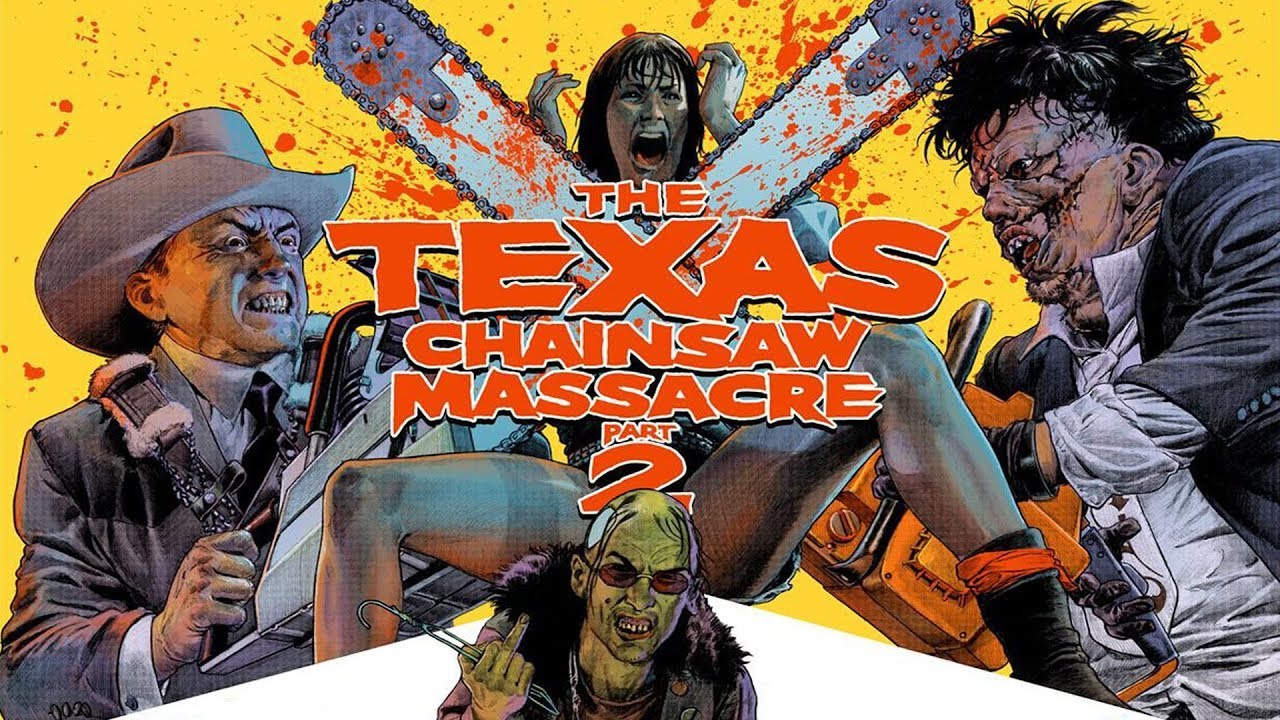The Texas Chainsaw Massacre 2 (1986) – A Chainsaw Symphony of Horror and Hilarity

The Texas Chainsaw Massacre 2 (1986) – A Chainsaw Symphony of Horror and Hilarity
The Texas Chainsaw Massacre 2, unleashed on August 22, 1986, takes the raw, visceral terror of Tobe Hooper’s 1974 masterpiece and spins it into a wild, surreal sequel that’s equal parts horrifying and hilarious. Directed once more by Hooper, this follow-up trades the original’s suffocating realism for a grotesque carnival of horror, satire, and black comedy, amplifying the chaos while wielding a chainsaw through the excesses of the 1980s. Far from a mere rehash, it’s a bold reinvention—maintaining the chilling legacy of Leatherface and his cannibal clan while drenching it in neon-lit absurdity and twisted humor. For better or worse, TCM 2 is a fever dream of a film, a polarizing yet unforgettable chapter in the franchise’s blood-soaked saga.
Plot and Setting: A Neon Nightmare in Texas
Set 13 years after the original’s harrowing events, The Texas Chainsaw Massacre 2 shifts the action from the desolate backroads of 1973 to a garish, Reagan-era Texas awash in rock music and urban sprawl. The Sawyer family—those deranged, flesh-eating outcasts—have evolved from rural recluses into a subterranean menace, lurking beneath an abandoned amusement park called Texas Battle Land. Their reign of terror resurfaces when two obnoxious yuppies, cruising in a Mercedes, taunt a local radio station during a late-night broadcast. The DJ, Stretch Brock (Caroline Williams), unwittingly records their demise as Leatherface (Bill Johnson) and his unhinged brother Chop Top (Bill Moseley) shred the car—and its occupants—with chainsaws and manic glee.
Stretch, a tough-as-nails yet vulnerable radio host at K-OKLA, becomes the film’s reluctant heroine. Her broadcast of the murder draws the attention of both the Sawyers and Lefty Enright (Dennis Hopper), a vengeful ex-Texas Ranger and uncle to the original film’s victims, Sally and Franklin Hardesty. Lefty, armed with his own arsenal of chainsaws and a thirst for justice, enlists Stretch to lure the killers out, thrusting her into a nightmarish chase for survival. The Sawyers—Leatherface, Chop Top, the decrepit Drayton (Jim Siedow, reprising his role), and a mummified Grandpa (Ken Evert)—unleash their full depravity, from skinning victims alive to serving chili laced with human flesh at a local cook-off. As Stretch navigates their underground lair—a labyrinth of bones, Christmas lights, and carnival detritus—she uncovers the family’s grotesque evolution, culminating in a chainsaw duel that’s as absurd as it is brutal.
Characters: A Gallery of Ghouls and Grit
Caroline Williams’ Stretch is the beating heart of TCM 2, a stark contrast to the original’s screaming final girl, Sally. With her big hair, denim grit, and quick wits, Stretch embodies the 1980s survivor—resourceful, defiant, and unafraid to wield a chainsaw herself. Williams infuses her with a raw charisma, balancing terror with tenacity as she shifts from bystander to avenger. Her chemistry with Hopper’s Lefty, a wild-eyed crusader teetering on madness, grounds the film’s lunacy. Hopper, fresh off Blue Velvet (1986), chews scenery with gusto—his “Lord have mercy!” rants and chainsaw-waving bravado make Lefty a tragicomic foil to the Sawyers’ evil.
Leatherface, now played by Bill Johnson, remains the hulking, masked centerpiece, his chainsaw an extension of his fractured psyche. Unlike the primal force of 1974, this Leatherface is oddly humanized—awkwardly smitten with Stretch, he dances with her in a bizarre courtship scene, his grunts and twitches hinting at a stunted soul beneath the flesh mask. Bill Moseley’s Chop Top, however, steals the show. A Vietnam vet with a metal plate in his skull (which he picks at with a coat hanger), Chop Top is a cackling, tie-dye-clad psychopath whose ramblings—“Nam flashback!”—and sadistic glee make him a standout. His debut here launched Moseley into horror icon status, a legacy cemented in later franchise entries. Jim Siedow’s Drayton, the family patriarch, adds a layer of dark entrepreneurship, peddling his “award-winning” chili with a wink, while Grandpa, barely alive, shuffles through scenes as a grotesque relic.
Tone and Style: Horror Meets Satire
Where the original Texas Chainsaw Massacre was a relentless descent into dread—its grainy 16mm look and documentary vibe amplifying the terror—TCM 2 takes a hard left into surreal excess. Hooper, freed from the low-budget constraints of 1974 (and backed by Cannon Films’ $4.7 million), unleashes a vision that’s both a love letter to horror and a middle finger to its conventions. The violence is cartoonishly over-the-top—faces peeled like fruit, bodies pulped by saws—yet punctuated with gallows humor. Drayton’s quip, “The small businessman always gets it in the ass,” or Chop Top’s serenade to a corpse with Oingo Boingo’s “Dead Man’s Party,” turn gore into grotesque comedy. It’s a tonal tightrope—horror fans expecting pure fright might recoil, but those in on the joke find a perverse delight.
The film’s aesthetic mirrors this shift. Cinematographer Richard Kooris bathes Texas in neon pinks and greens, trading the original’s sun-bleached desolation for a nightmarish funhouse vibe. The Sawyer lair, designed by Cary White, is a masterpiece of macabre kitsch—skulls strung with fairy lights, a throne of bones, a swampy tunnel dripping with decay. The soundtrack, a mix of Hooper’s eerie synths and 1980s rock (The Cramps, Timbuk 3), pumps adrenaline into the chaos, setting a rhythm that’s as unsettling as it is infectious. It’s Texas as a fever dream, a satirical mirror to the decade’s glitz and greed.
Themes: Family, Excess, and the American Dream
Beneath the blood and laughs, TCM 2 skewers the American family and the 1980s ethos. The Sawyers, with their twisted domesticity—Drayton as the breadwinner, Leatherface as the dutiful son—parody the nuclear ideal, their “family business” a grotesque take on capitalism. The chili cook-off scene, where Drayton wins a prize for his human-flesh recipe, is a biting jab at consumerism—America eating itself alive under a veneer of success. Chop Top’s Vietnam scars and Lefty’s vigilante zeal nod to a nation wrestling with its past, while Stretch’s fight for survival reflects a scrappy individualism against overwhelming odds. It’s not subtle, but it’s sharp—a horror-comedy lens on a culture obsessed with excess.
Production and Reception: A Chainsaw’s Second Cut
After the original’s grueling shoot and cult status, Hooper faced pressure to sequelize. Cannon Films, known for schlock like Death Wish 3, pushed for a bigger, brasher follow-up, granting Hooper creative control but meddling with edits (a gorier director’s cut exists). Filmed in Austin, Texas, the production was a chaotic echo of 1974—long nights, real chainsaws (albeit dulled), and a cast embracing the madness. Williams trained with a 30-pound saw, while Moseley improvised Chop Top’s quirks, cementing his legacy. Released unrated to dodge an X rating, TCM 2 grossed $8 million against its budget—a modest hit, but a far cry from the original’s $30 million haul (adjusted).
Critics were split. Roger Ebert gave it one star, decrying its “juvenile” humor, while Variety praised its “manic energy.” Fans, too, were divided—some mourned the loss of raw terror, others embraced the gonzo vibe. Over time, its reputation grew, buoyed by VHS rentals and a cult following that saw it as a misunderstood gem. By March 27, 2025, nearly 40 years later, TCM 2 is a revered oddity—less a sequel than a reinvention, its influence felt in horror-comedy hybrids like Tucker & Dale vs. Evil (2010).
Legacy and Verdict
The Texas Chainsaw Massacre 2 isn’t for everyone. It’s not the suffocating nightmare of 1974, nor the slick slashers of its era like Friday the 13th. It’s a beast unto itself—a bloody, bawdy romp that dares to laugh at its own carnage. For horror buffs who relish terror with a wink, it’s a must-see, delivering visceral shocks and dark chuckles in equal measure. Hooper’s twisted vision, paired with standout turns from Williams and Moseley, makes it a standout in the franchise—a chainsaw symphony that cuts deeper the longer you listen.
Whether you see it as a brilliant satire or a gory misstep, TCM 2 is undeniably Tobe Hooper at his most unhinged—a love letter to the Sawyers and a middle finger to restraint. Strap in for a ride through Texas’ neon underbelly; it’s disturbing, it’s fun, and it’s unlike anything else.











